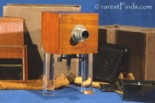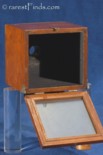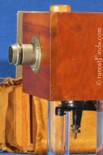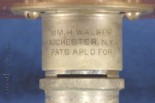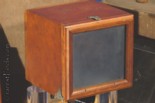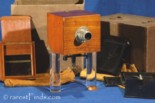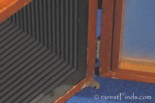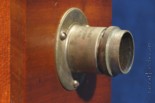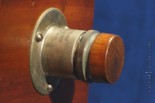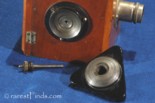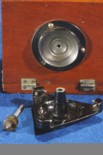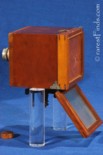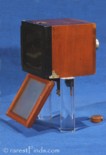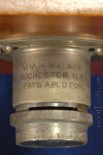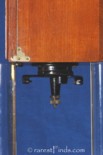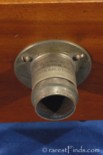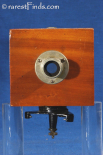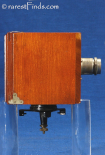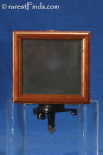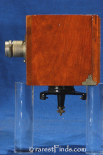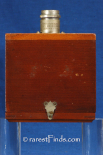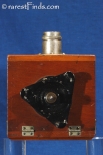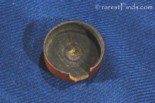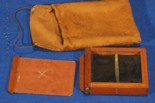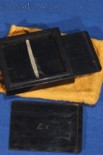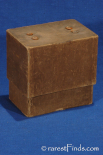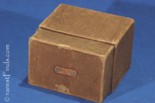Exceedingly rare and important Walker’s Pocket Camera, first Pocket Camera, patented in 1882; six years before the legendary Kodak! Only the fifth ever to be found!
Patents, click on any image to see larger image!
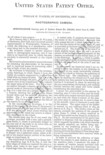
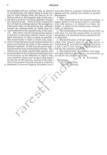


The exceedingly rare Walker Pocket Camera offered here is most likely the most complete outfit of its kind ever found; The Camera crafted in fine cherry wood with nickel-plated mountings,
achromatic wide angle lens signed “WM. H. WALKER, ROCHESTER. N.Y., PATS APLD FOR,” with Waterhouse slot to insert disc with three stops, wooden lens cover, the complete black japanned adjustable tripod head, and two hard-rubber or Gotta-Percha double dry-plate holders and one cherry-wood double dry-plate holder, all three in what appears to be the original pouches.
Interestingly, the article about Walker’s Pocket Camera published in the Manufacturer and Builder, May 1882, Volume 14, issue 5, page 102, lists the double dry-plate holder as made out of hard-rubber. This is an indication that by 1882 the originally made cherry wood dry-plate holders were replaced by hard-rubber holders. Together with the fact that the lens bears the remark “PATENTS APLD FOR” it is reasonable to assume that this camera was one of the first ever produced. The owner must have bought two additional dry-plate holders later on so he could take four photographs before developing the plates to make some prints.
Condition:
This camera is in very good condition. There are no defects, repairs, or missing parts. The disc with three stops to be inserted into the Waterhouse slot of the lens is not shown in any of the pictures but it is present; I discovered the part inside the box as I packed the camera after taking the pictures published here.
History:
Today, taking quality pictures is incredibly simple and can be done with any smart phone most everybody is carrying around at all times.
It is astonishing that just 180 years ago there was no photography at all.
It was Louis Jacques Mande Daguerre who invented the first process to take pictures. The images were called Daguerreotypes after his inventor and its development involved poisonous heated Mercury fumes. Daguerreotypists died at young age as no precautions were taken to prevent inhalation of the fumes. The process was improved over the years and other less hazardous materials were used.
Photography however involved heavy and very fragile glass plates — as the Walker Pocket Camera offered here — until George Eastman invented and patented his film for which the Patent with the title "PHOTOGRAPHIC FILM" was issued on October 14, 1884 (number 306,494).
Eastman expected photographers to give up using glass plates and instead would use his film for which he carried the patent. Eastman realized that he had to offer a film-back for existing cameras as photographers would not buy new cameras to make the change and use film. Another necessary step to his worldwide success was his patent with the title “ROLLER HOLDER FOR PHOTOGRAPHIC FILMS” which was the logic consequence and was issued on May 5, 1885 (number 317,050). Interestingly, the patent was issued not only to G. Eastman, but also to W.H.Walker. I will get back to that...
The importance of the invention of film was tremendous; instead of carrying the usual heavy glass double dry-plate holders, Photographers could carry just one film-back with a roll of film. This film-back would weigh two and three quarter pounds and would allow the taking of 50 photographs; 25 glass double dry-plate holders would weigh 50 lbs in comparison. The success was not as expected as photographers would stick to what they were familiar with. It would take another step by G. Eastman for the breakthrough.
The launching of the KODAK Pocket Camera which was marketed under the slogan, “You Press the Button, We do the Rest” made photography available to the world. The patent combined film, his film-back to accommodate and transport the film, a simple shutter, and the lens. The title to his Pocket Camera patent which he called KODAK was simply CAMERA. The patent was issued on September 4, 1888 (number 388,850).
Any amateur could take pictures with the KODAK by simply press the button and could
do that 100 times before the film was at the end. The camera then had to be sent to Rochester New York and Eastman did the rest. At the factory, film was separated from the camera, cut into strips of twelve exposures, developed and stripped, pressed in contact with a clear gelatin skin, and dried. Then, prints were made from each negative and pasted on mounts and returned to customers, along with the negatives, the camera loaded with a new roll of film ready to take pictures again for a price of $10.00.
Eastman's scheme to make his money by selling film was the same as today's scheme with selling printers for a low price and make the money with ink and toner cartridges. The KODAK pictures were round with a diameter of 2-1/2 inches. The KODAK was legendary and considered the first Pocket Camera with roll film.
While Eastman deserves credit for the first Pocket Camera with roll film, Walker deserves credit for the first Pocket Camera. Walker still used glass dry-plates with his Pocket Camera.
Walker was not a good business man and is little known for his achievements. For his invention, he was issued the patent with the title PHOTOGRAPHIC CAMERA on June 6, 1882 (number 259,064). The camera offered here bears the remark, “PATS APLD FOR”. An indication that the camera was manufactured before 1882. In 1883, Walker sold his business. This explains why this camera is so scarce. According to information I found on the Internet, the Walker offered here is only the fifth surviving example known to exist. Walker's patent includes his claim to prevent light reflections to occur in small spaces such as inside a pocket camera. To prevent reflections to get to the sensitive plate, he crafted the inside of his camera with “grooves running in a direction transverse to the optical axis.” These grooves can clearly be seen in picture #7 above.
Also protected by his patent was the “spherical Joint” of his tripod-head which allowed to position the camera without moving or adjusting the legs of the tripod. The spherical head is shown in picture #10 and 11.
At the time Walker was issued his patent for his Pocket Camera, he was only in business for two years. The company he founded in 1880 was called Wm. H. Walker & Co. and was located in Rochester, New York. In 1883, he sold his company to W. F. Carlton who renamed the company to Rochester Optical Co. Shortly after, Walker teamed up with George Eastman. Together they invented the roll-film back which they patented in 1885.
Walker's Pocket Photographic Camera:
(The Manufacturer and Builder, May 1882, Volume 14, Issue 5, page 102)
Amateur photography is a comparatively new and certainly most fascinating and useful occupation and pastime, and is rapidly becoming generally popular. The professional no longer occupies the wonderfully interesting field of photography undisputed. The march of progress has given us the “dry-plate process,” By means of which, and with the use of proper apparatus, any one, without experience or previous knowledge of the art, may take fine photographic views of landscapes, buildings, drawings or other objects
(The Manufacturer and Builder, May 1882, Volume 14, Issue 5, page 102)
Mr. Walker, of the firm of Wm. H. Walker & Co., of Rochester, N.Y., at the Cincinnati Industrial Exposition, held last August, exhibited what is known as Walker’s Pocket Camera, with complete photographic outfit for amateurs’ use. The pocket camera answers every requirement for the amateur, is made of well-seasoned old cherry, with fine achromatic, wide-angle lens (giving remarkable depth of focus and flatness of field), nickel-plated mountings, adjustable tripod head, with folding legs, and a hard-rubber, double dry-plate holder. It is accurate and compact, weighing but two pounds; size of box outside, 4x4x5 inches, thereby requiring so little room as to be invaluable to tourists who cannot be burdened with cumbersome apparatus.
The accompanying engraving gives a view of this miniature but effective apparatus, representing it mounted ready for use, while the case below, in which it can be packed and swung over the shoulder, gives a good idea of its portability. A complete out-fit consists of the camera as above, also the few and simple chemicals required for developing the plates, a ruby lamp, dark box, one dozen plates, sensitive paper on which to print the photograph, printing frame, card mounts, and an instruction book giving full directions as to details.
By the use of these cameras and outfits, any one, with a very little practice, is enabled to produce fine work. As before stated, the dry plates are capable of retaining the latent image after exposure, indefinitely, so that having become accustomed to judge the proper time a plate should be exposed in a given light, any number of plates may be exposed and packed away during a summer’s trip, to be developed at some convenient time at home. The entire process is simple and interesting, and when once attempted, fascinates beyond description. Architects, builders and droughts men will be re-minded, in reading this, of the many ways in which such an instrument may be made useful in their professional work. Mr. Walker has prepared a very interesting and instructive manual on the practice of dry-plate photography, with the taking title of “The Amateur Photographer,” from which many additional details may be gleaned by those desirous of inquiring further into the subject. To all such we would suggest writing Messrs.
W. H. Walker & Co., Rochester, N. Y.
To read more, click here!
William H. Walker
Mr. Walker was born in Scio, Michigan, July 26, 1846. His preliminary education was obtained at several boarding schools. Very early he evinced a decided interest in engineering science. Owing to reverses met by his father, he was obliged to think of his own support and, without the approval of his family, started as an apprentice at Colts Armory at Hartford. Mr. Walker has said of this part of his life’s experience: “Twist drills, taps, dies, and reamers were not made commercially until they were made at Colt’s Armory; and here, as far as I know, was established the first organized tool room. The entire system of drop forgings was developed at Colt’s Armory, and also the system of manufacturing interchangeable parts, which system was first suggested by Eli Whitney, a New England schoolmaster, the inventor of the cotton gin.”
During his connection with the Morgan Iron Works, he attended night school at the Cooper Institute, completing the full course in mathematics and mechanical drawing. On the completion of this course, he became a partner in a firm interested in the manufacture of machinery, and traveled over practically the entire United States representing this firm and introducing their products. This connection was deliberately undertaken by Mr. Walker, with the idea of familiarizing himself with all branches of the manufacturing business, and with machinery and processes in general.
During certain investigations into the history of the gas engine, he was struck with what appeared to be contradictory practices and designs, and so attempted to procure financial assistance to prosecute some independent experiments, having in mind the obtaining of correct engine cylinder diagrams. Failing to obtain this necessary financial support, he then directed his attention to a complete study of the photographic processes from the earliest known down to the then new “dry plate” process. At that time this new process was little understood and was giving no little trouble to the manufacturers.
For a year his attention was directed wholly to these photographic studies, which were supplemented by experiments with practically all the then known processes and apparatus. The result of these investigations was the development on a commercial scale of a small camera for amateurs known as Walker’s Pocket Camera. This camera attained a marked success and was purchased particularly by engineers for facilitating preliminary surveys of projected railways and other works. It was the first camera specially adapted to the needs and capabilities of amateurs.
During this year of experiment, he became convinced that a substitute could be made for glass for the manufacture of photographic plates and, after about six months of work, produced a film and was successful in producing negatives and prints.
It was soon after this that he associated himself with a concern known at that time as the Eastman Dry Plate Company of Rochester, and, in his position as technical expert, he perfected the first commercial roll holder for exposures. This roll holder was a fore-runner of the practical hand camera which has since become familiar throughout the world under the trade name of “Kodak.”
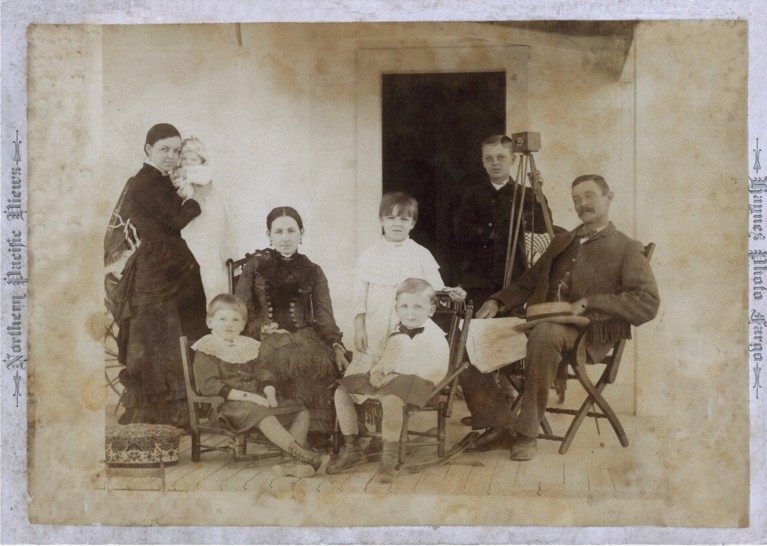
Image courtesy of AntiqueCameras.net
During Mr. Walker’s early years with the Eastman Company, he perfected the first set of machinery for coating photographic films and paper of continuous length; also machinery for automatically dividing glass plates which, at that time, were but poorly cut and, in many instances, due to these eccentricities, would not enter the commercial plate holders. He also perfected machinery for automatically spooling the films and for determining the exact amount of film required.
Many patents were taken out for these inventions which were the initial efforts of the Eastman Dry Plate Company to perfect a complete system of film photography and coated papers.
Mr. Walker went to London many years ago to make an exhibit of the products of the Eastman Company before the Inventions Exhibition and, as a result, the company was awarded the highest prize for progress. As a further result of this London trip, Mr. Walker opened an office in London, finally becoming the Managing Director of an English Eastman Company. This was the beginning of the present branch system whereby the home company is represented by its own agents in many of the capitals of the world, thus keeping the parent company in close touch with the world’s needs and demands.
Mr. Walker retired from active business some thirty years ago, and has devoted himself of late years particularly to microscopic studies and many interesting engineering problems in connection with the development of his estate in the Berkshire Hills.
We are privileged to add a brief account of a trip made in 1862 to China by Mr. Walker, then a boy of sixteen:
I made a trip to China in the year 1862, on a steamship built for Russell & Company of China. This ship was modeled after the North River type and was known as the Hugh Quang. The quards or projecting decks, which, starting from the sides of the hull enclosed the paddle boxes, were fitted with sponsons, which connected the outer edges of the guards with the hull. The object of these sponsons was to break the force of the seas, but before we were well into the gulf stream we cut out every other plank from both sponson and guards, and even then we could not keep anything in the racks of the steward’s pantry on account of the shattering effect of the seas, which sometimes seemed as if they would lift the entire deck.The engine was the old-fashioned beam engine 60” bore and twelve feet stroke. The entire vessel was stiffened with what is known as a ‘hog’ frame, which was tied together with 2” and 2 ½” rods tightened with turn buckles.
These rods were continually breaking, and so a constant watch was necessary, especially during rough weather; and during the crossing of the Mozambique Channel we had busy night keeping these rods intact. The blacksmiths gave out and we commandeered two of the engineers as smithies, and I stood watch for two hours working the engines by hand. This was the toughest job I ever had, feeling as it were for the coming sea; for the only way was to feel the bow rising and judge when the wave had struck the paddles and ease her off and then catch her again before she went “dead”.
All Chinese boats have two eyes painted one on either side of the bow, for, as the Chinese say, “No have eye, how can see; no can see, how can walkee?” So all ships in the coastwise trade of China have two eyes. This ship was built to run on the Yangtze River.
We made the fastest run from New York to Shanghai, of over 14,000 miles, in 58 running days. We then took her masts out. I was appointed purser and went up to Hankau, which at that time was the head of navigation.
We all went armed out there. Having charge of three hundred coolies, all potential pirates, was no joke if they ever took a notion to run amuck. Going up the river we gave three dinners, one for the Chinese officials, consuls etc.; one for the merchant class (High Chop Men); and a third for merchants of lesser degree.
The Taiping rebellion was on at that time and the river was full of dead bodies, sometimes tied to pigs or other animals. When we tried to turn the engines over preparatory to departure from Shanghai, we were unable to move until we went down into the paddle boxes and cut the dead bodies away. This was not pleasant work with the thermometer at 110 F., and a moist atmosphere.
I made plenty of spending money bringing down Chinese cash and making the difference in exchange between Shanghai and Han-kau. “To give an idea of the customs in those days, my position as purser entitled me to my full proportion in the following daily allowances: a. bottle of champagne and a bottle of port for four; a bottle of whiskey and a bottle of sherry for two; and beer, mineral water, and ginger ale without limit, and the amount of liquids consumed was sometimes astonishing.”
William H. Walker was an extrem prolific man. In 1904 he purchased the Brookside Estate located in Great Barrington, Massachusetts. The previous owner, William Stanley, was the holder of 129 patents and the man who spurred the development of AC (Alternating Current) with his first practical transformer. Among his inventions was also the steel vacuum bottle, also known as thermos bottle, which still today carry the trade name Stanley.
Here is a link to the history of the Brookside Estate which today is known as the Elsner Camp.
William Hall Walker died on November 29, 1917, a wealthy man. According to the New York Times, his fortune was appraised at $4,600,782; $3,510,815 of his fortune was his stock-holding in the Eastman Kodak Company. The follwoing obituary was printed the next day in the Sun news paper:
William Hall Walker, millionaire inventor and a philanthropist who had made many large gifts to charitable and educational Institutions, died yesterday afternoon at his home, in 23 West Fifty-forth street. He was 71 years old.
Mr. Walker was born in Scio, Mich., and was educated as a mechanical engineer. Later he turned his attention to photography, and when the Eastman Kodak Company was organized he became head of its European branch and spent twenty years in London. While there he invented many improvements on photograpahy, which brought him a large fortune.
His philanthropic activities covered a period of many years, among his most recent gifts being $100,000 to Stevens Institute, $25,000 to the Mechanical Institute and $50,000 to the Red Cross. For the last ten years he had made his home in New York and at his country place in Great Barrington, one of the most ornate estates in New England. It comprises a thousand acres of land which he purchased in 1908. He is survived by a widow and one daughter.
Funeral services will be held in the Frank E. Cambell Funeral Church, with interment in Stockbridge Mass.
Inventory Number 09288;
Sold!
